Numeracy 2 Assignment: Analysis of Numeracy Concepts and Skills
VerifiedAdded on 2020/06/03
|17
|2037
|174
Homework Assignment
AI Summary
This Numeracy 2 assignment solution covers various concepts including the laws of indices, root laws, and their applications. It provides solutions to problems involving simple, compound, semi-annually, and quarterly compound interest calculations. The assignment further explores the concept of Net Present Value (NPV), and its application in advising a trading company. It includes a tally of data sets, histogram drawing, and comments on marks distribution. Real-life illustrations of probability applications and symmetry characteristics are also discussed. The assignment concludes with real-life examples and a reflective log, summarizing the student's understanding and confidence levels in the covered concepts, along with areas for improvement.
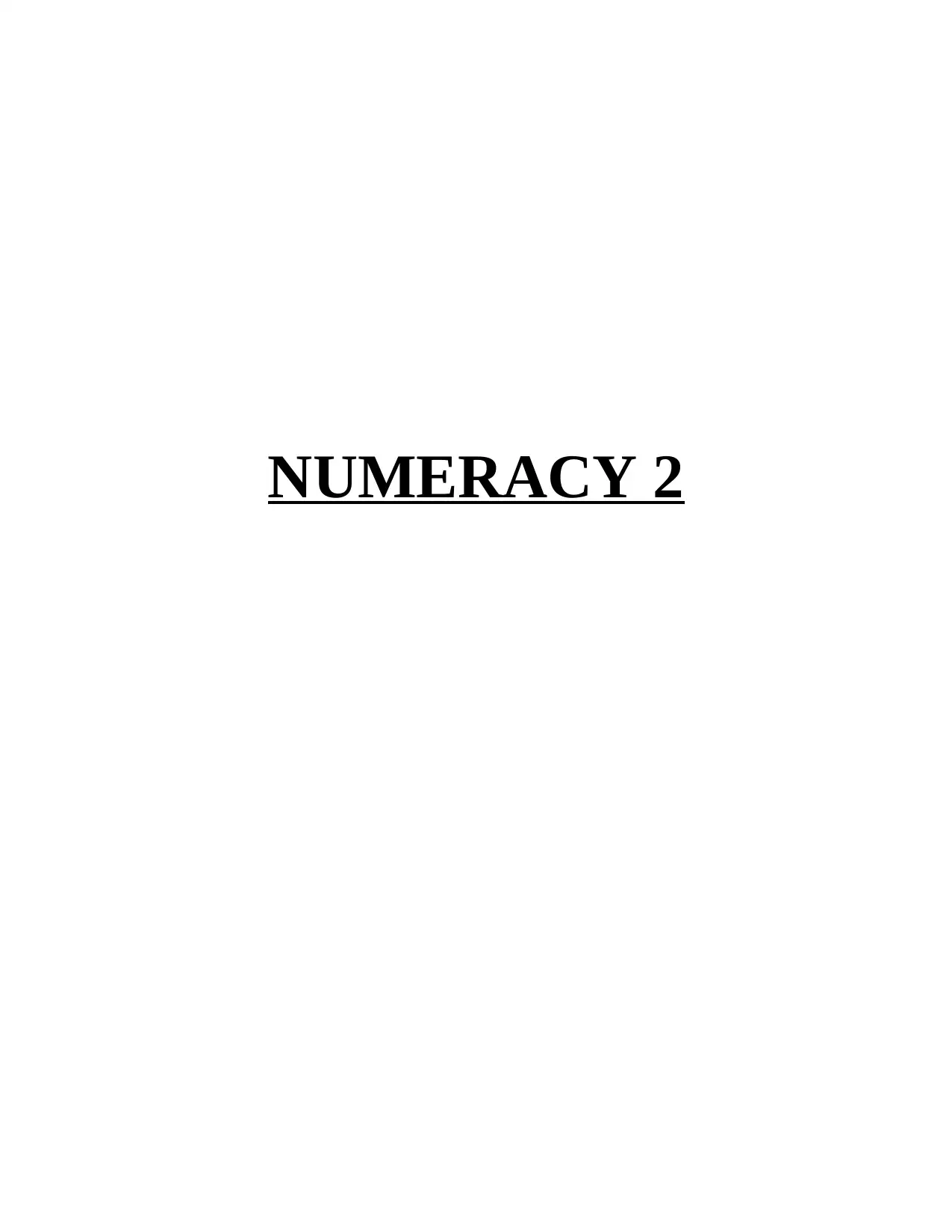
NUMERACY 2
Paraphrase This Document
Need a fresh take? Get an instant paraphrase of this document with our AI Paraphraser
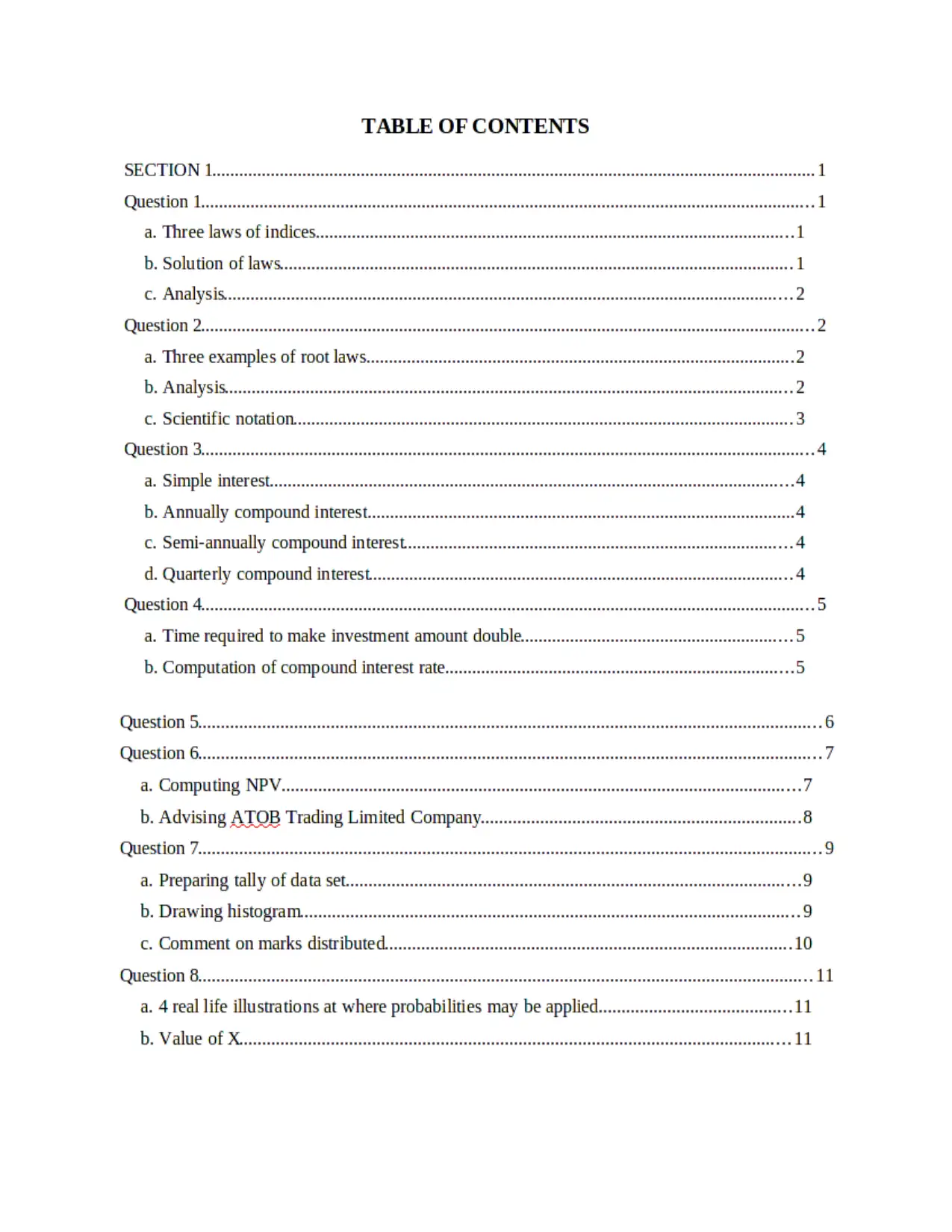
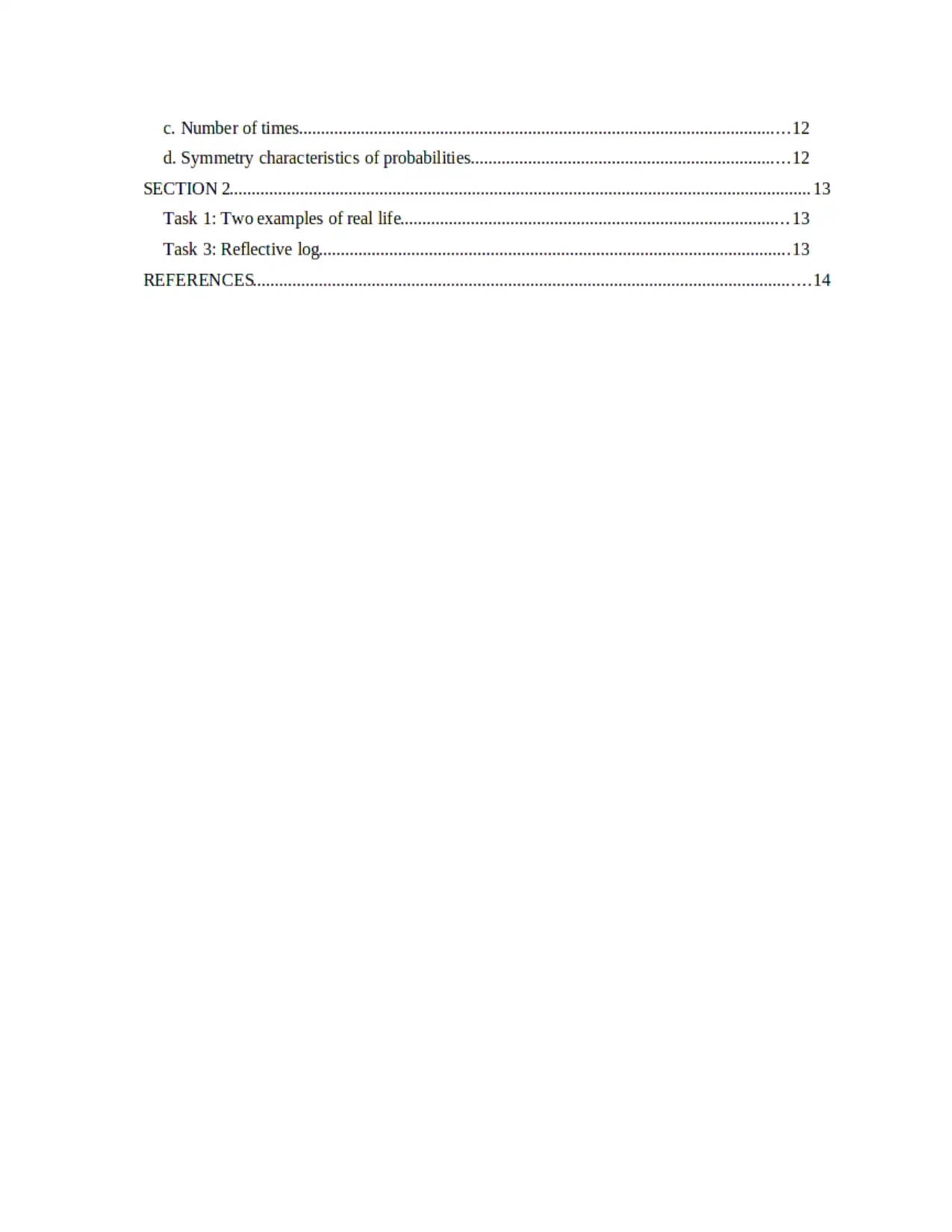
⊘ This is a preview!⊘
Do you want full access?
Subscribe today to unlock all pages.

Trusted by 1+ million students worldwide
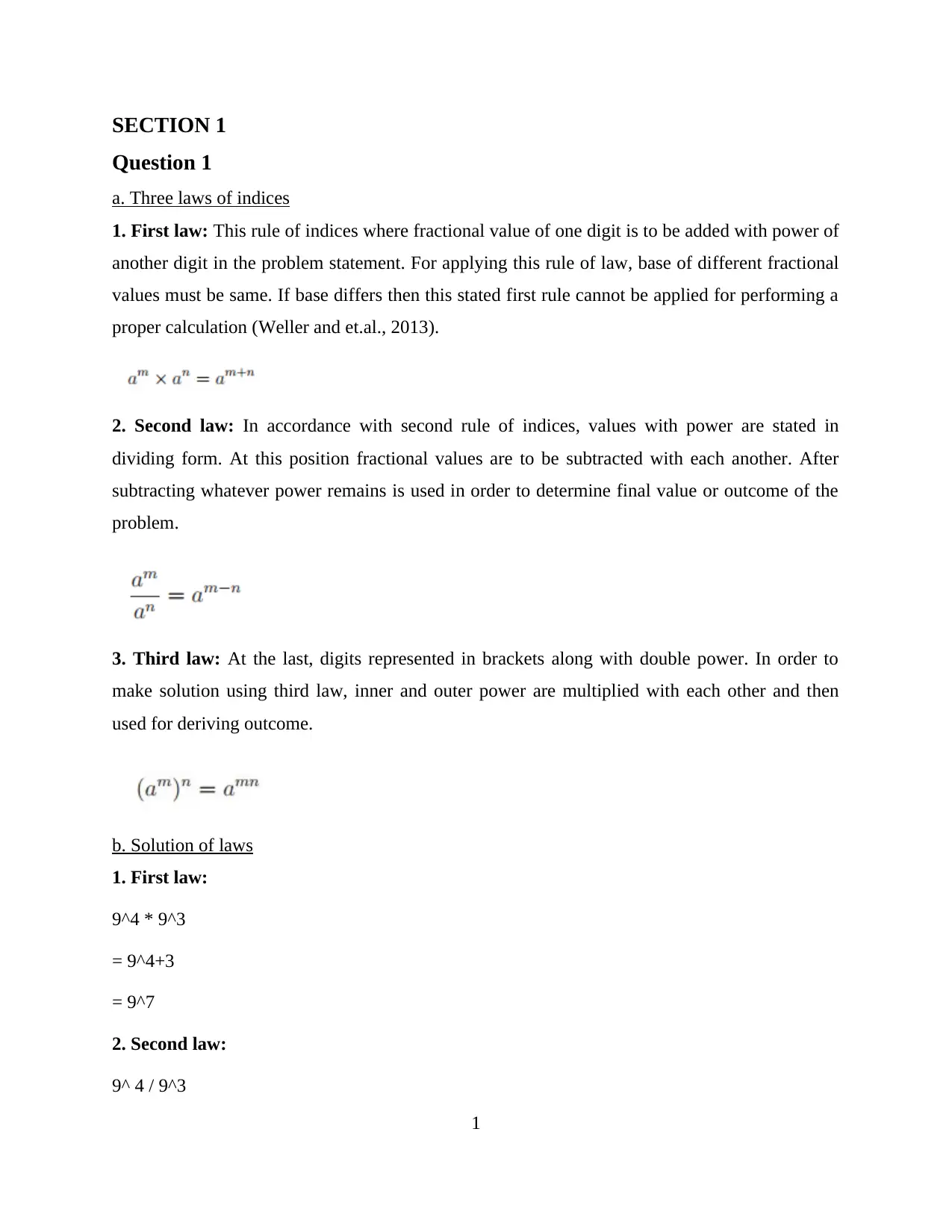
SECTION 1
Question 1
a. Three laws of indices
1. First law: This rule of indices where fractional value of one digit is to be added with power of
another digit in the problem statement. For applying this rule of law, base of different fractional
values must be same. If base differs then this stated first rule cannot be applied for performing a
proper calculation (Weller and et.al., 2013).
2. Second law: In accordance with second rule of indices, values with power are stated in
dividing form. At this position fractional values are to be subtracted with each another. After
subtracting whatever power remains is used in order to determine final value or outcome of the
problem.
3. Third law: At the last, digits represented in brackets along with double power. In order to
make solution using third law, inner and outer power are multiplied with each other and then
used for deriving outcome.
b. Solution of laws
1. First law:
9^4 * 9^3
= 9^4+3
= 9^7
2. Second law:
9^ 4 / 9^3
1
Question 1
a. Three laws of indices
1. First law: This rule of indices where fractional value of one digit is to be added with power of
another digit in the problem statement. For applying this rule of law, base of different fractional
values must be same. If base differs then this stated first rule cannot be applied for performing a
proper calculation (Weller and et.al., 2013).
2. Second law: In accordance with second rule of indices, values with power are stated in
dividing form. At this position fractional values are to be subtracted with each another. After
subtracting whatever power remains is used in order to determine final value or outcome of the
problem.
3. Third law: At the last, digits represented in brackets along with double power. In order to
make solution using third law, inner and outer power are multiplied with each other and then
used for deriving outcome.
b. Solution of laws
1. First law:
9^4 * 9^3
= 9^4+3
= 9^7
2. Second law:
9^ 4 / 9^3
1
Paraphrase This Document
Need a fresh take? Get an instant paraphrase of this document with our AI Paraphraser
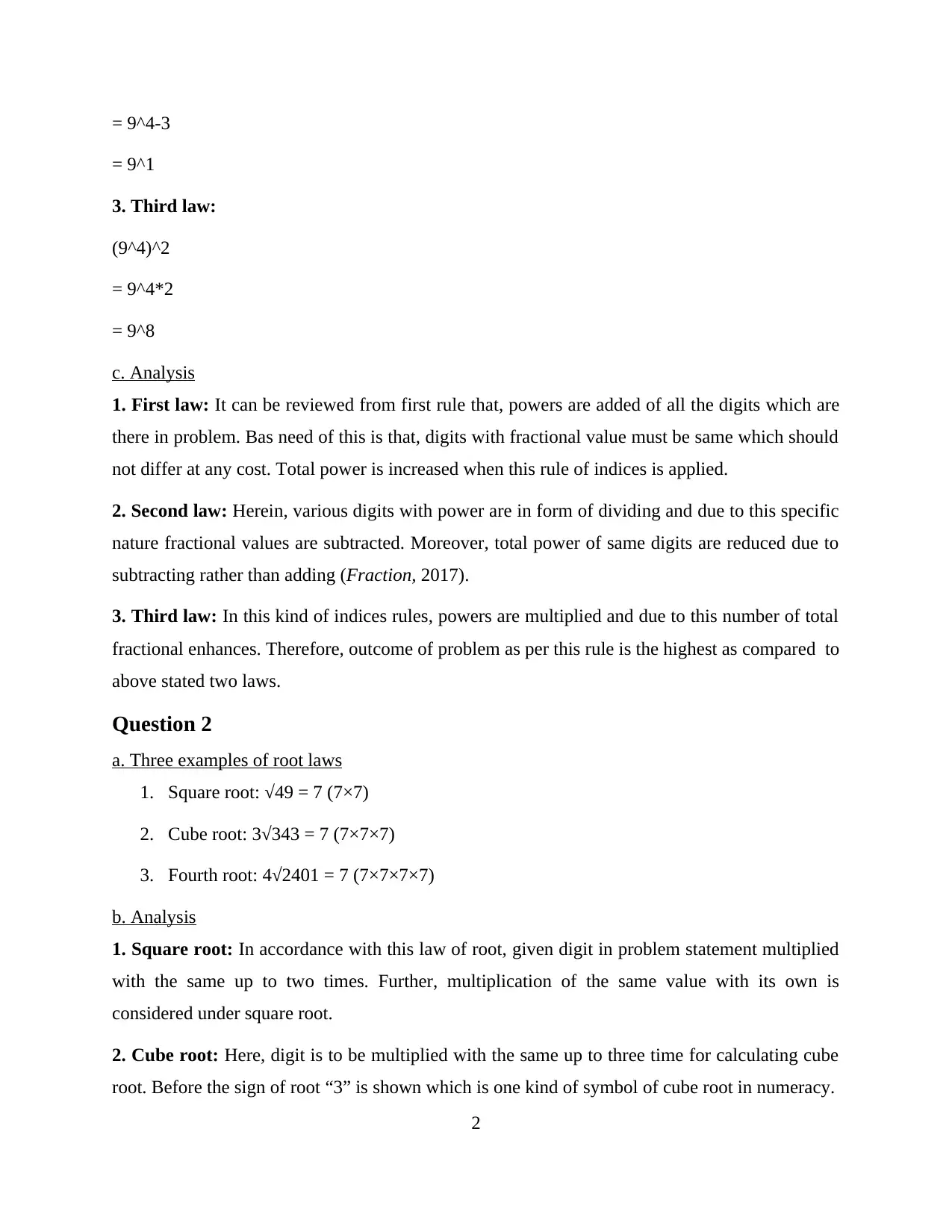
= 9^4-3
= 9^1
3. Third law:
(9^4)^2
= 9^4*2
= 9^8
c. Analysis
1. First law: It can be reviewed from first rule that, powers are added of all the digits which are
there in problem. Bas need of this is that, digits with fractional value must be same which should
not differ at any cost. Total power is increased when this rule of indices is applied.
2. Second law: Herein, various digits with power are in form of dividing and due to this specific
nature fractional values are subtracted. Moreover, total power of same digits are reduced due to
subtracting rather than adding (Fraction, 2017).
3. Third law: In this kind of indices rules, powers are multiplied and due to this number of total
fractional enhances. Therefore, outcome of problem as per this rule is the highest as compared to
above stated two laws.
Question 2
a. Three examples of root laws
1. Square root: √49 = 7 (7×7)
2. Cube root: 3√343 = 7 (7×7×7)
3. Fourth root: 4√2401 = 7 (7×7×7×7)
b. Analysis
1. Square root: In accordance with this law of root, given digit in problem statement multiplied
with the same up to two times. Further, multiplication of the same value with its own is
considered under square root.
2. Cube root: Here, digit is to be multiplied with the same up to three time for calculating cube
root. Before the sign of root “3” is shown which is one kind of symbol of cube root in numeracy.
2
= 9^1
3. Third law:
(9^4)^2
= 9^4*2
= 9^8
c. Analysis
1. First law: It can be reviewed from first rule that, powers are added of all the digits which are
there in problem. Bas need of this is that, digits with fractional value must be same which should
not differ at any cost. Total power is increased when this rule of indices is applied.
2. Second law: Herein, various digits with power are in form of dividing and due to this specific
nature fractional values are subtracted. Moreover, total power of same digits are reduced due to
subtracting rather than adding (Fraction, 2017).
3. Third law: In this kind of indices rules, powers are multiplied and due to this number of total
fractional enhances. Therefore, outcome of problem as per this rule is the highest as compared to
above stated two laws.
Question 2
a. Three examples of root laws
1. Square root: √49 = 7 (7×7)
2. Cube root: 3√343 = 7 (7×7×7)
3. Fourth root: 4√2401 = 7 (7×7×7×7)
b. Analysis
1. Square root: In accordance with this law of root, given digit in problem statement multiplied
with the same up to two times. Further, multiplication of the same value with its own is
considered under square root.
2. Cube root: Here, digit is to be multiplied with the same up to three time for calculating cube
root. Before the sign of root “3” is shown which is one kind of symbol of cube root in numeracy.
2
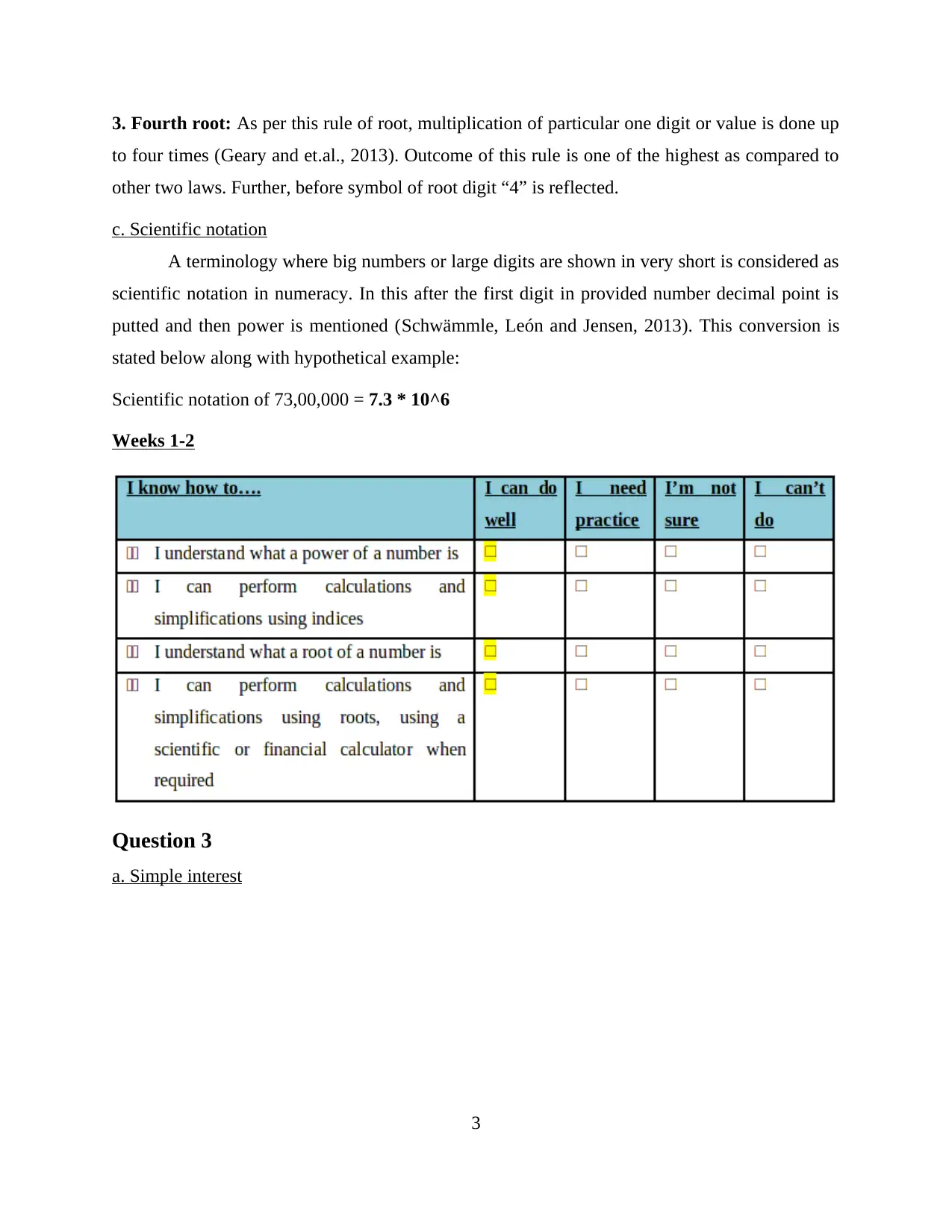
3. Fourth root: As per this rule of root, multiplication of particular one digit or value is done up
to four times (Geary and et.al., 2013). Outcome of this rule is one of the highest as compared to
other two laws. Further, before symbol of root digit “4” is reflected.
c. Scientific notation
A terminology where big numbers or large digits are shown in very short is considered as
scientific notation in numeracy. In this after the first digit in provided number decimal point is
putted and then power is mentioned (Schwämmle, León and Jensen, 2013 ). This conversion is
stated below along with hypothetical example:
Scientific notation of 73,00,000 = 7.3 * 10^6
Weeks 1-2
Question 3
a. Simple interest
3
to four times (Geary and et.al., 2013). Outcome of this rule is one of the highest as compared to
other two laws. Further, before symbol of root digit “4” is reflected.
c. Scientific notation
A terminology where big numbers or large digits are shown in very short is considered as
scientific notation in numeracy. In this after the first digit in provided number decimal point is
putted and then power is mentioned (Schwämmle, León and Jensen, 2013 ). This conversion is
stated below along with hypothetical example:
Scientific notation of 73,00,000 = 7.3 * 10^6
Weeks 1-2
Question 3
a. Simple interest
3
⊘ This is a preview!⊘
Do you want full access?
Subscribe today to unlock all pages.

Trusted by 1+ million students worldwide
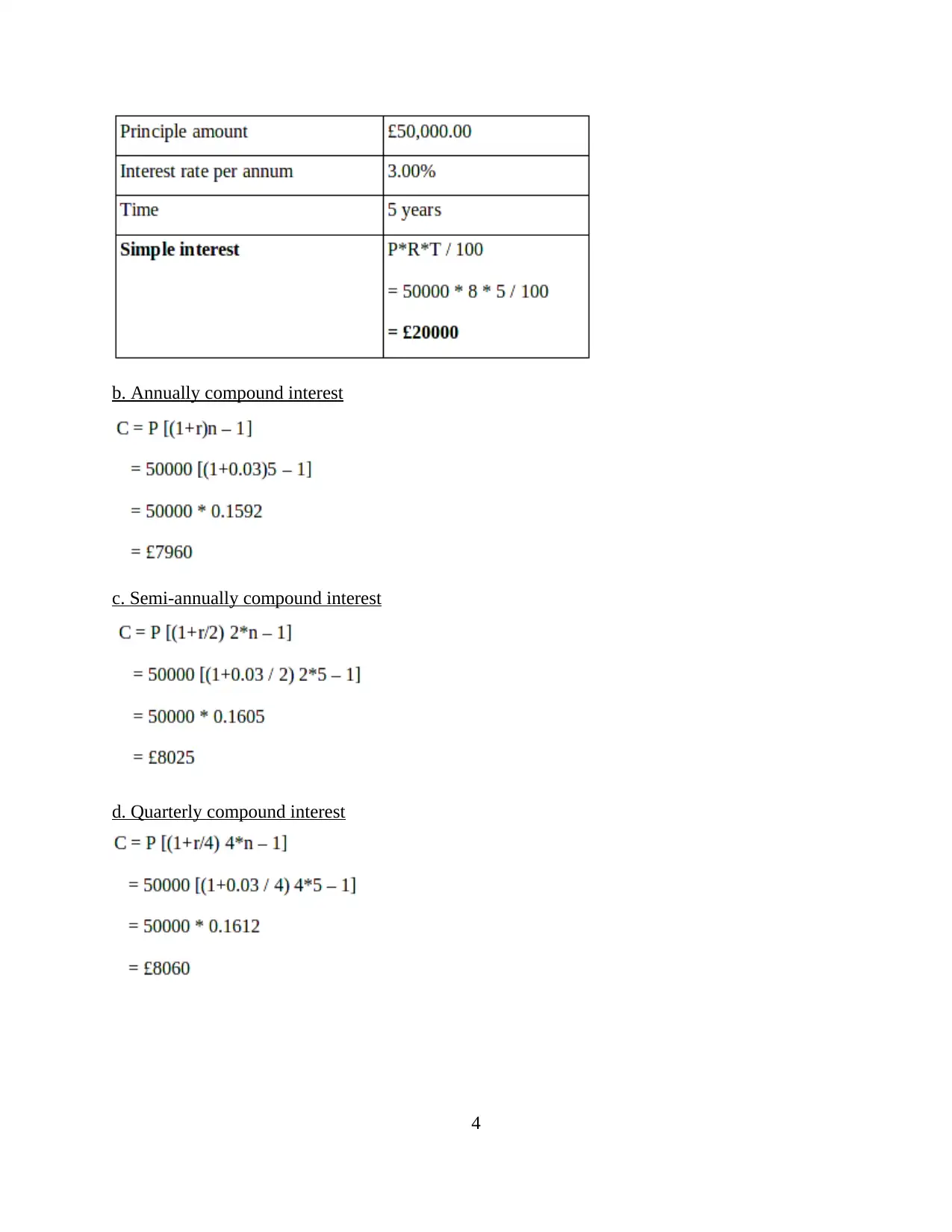
b. Annually compound interest
c. Semi-annually compound interest
d. Quarterly compound interest
4
c. Semi-annually compound interest
d. Quarterly compound interest
4
Paraphrase This Document
Need a fresh take? Get an instant paraphrase of this document with our AI Paraphraser
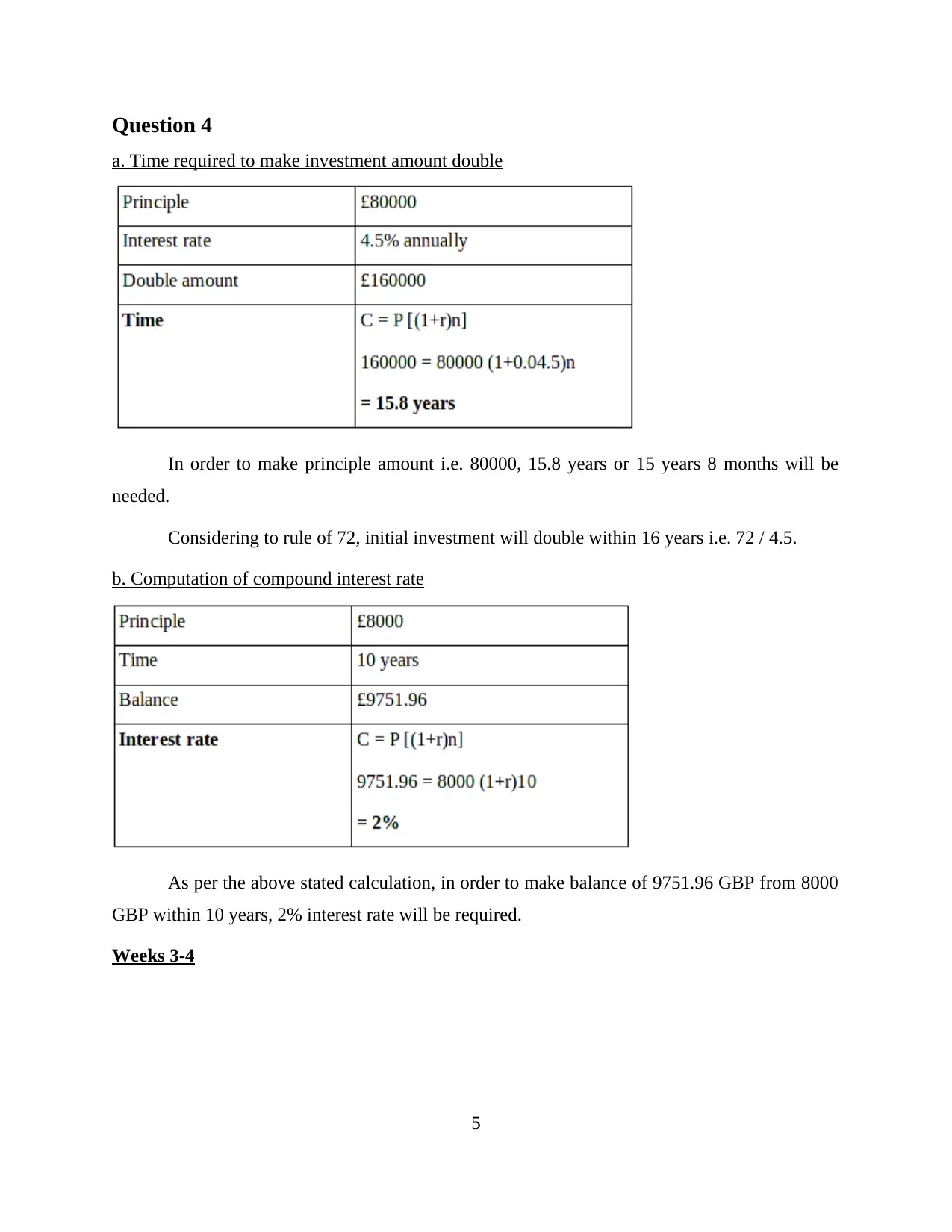
Question 4
a. Time required to make investment amount double
In order to make principle amount i.e. 80000, 15.8 years or 15 years 8 months will be
needed.
Considering to rule of 72, initial investment will double within 16 years i.e. 72 / 4.5.
b. Computation of compound interest rate
As per the above stated calculation, in order to make balance of 9751.96 GBP from 8000
GBP within 10 years, 2% interest rate will be required.
Weeks 3-4
5
a. Time required to make investment amount double
In order to make principle amount i.e. 80000, 15.8 years or 15 years 8 months will be
needed.
Considering to rule of 72, initial investment will double within 16 years i.e. 72 / 4.5.
b. Computation of compound interest rate
As per the above stated calculation, in order to make balance of 9751.96 GBP from 8000
GBP within 10 years, 2% interest rate will be required.
Weeks 3-4
5
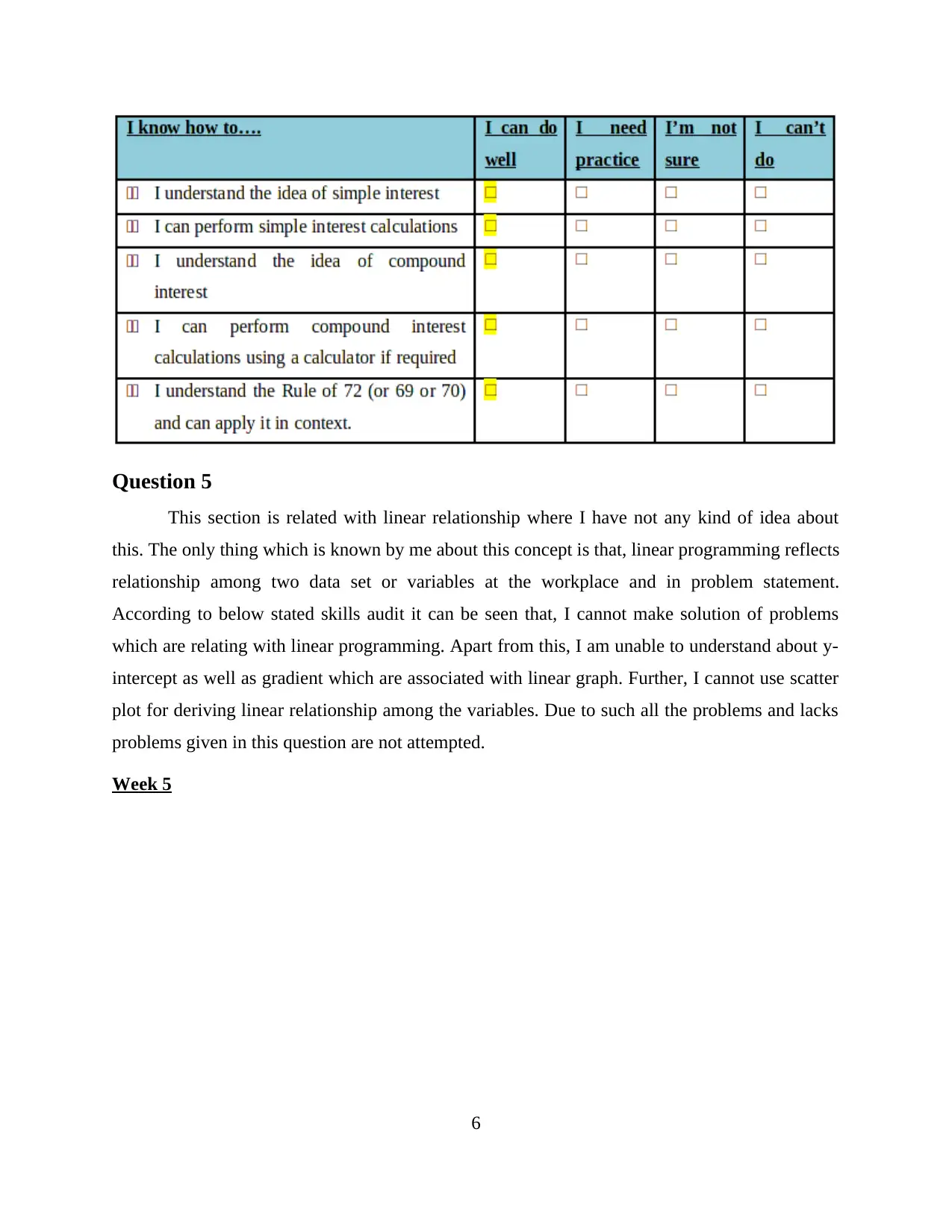
Question 5
This section is related with linear relationship where I have not any kind of idea about
this. The only thing which is known by me about this concept is that, linear programming reflects
relationship among two data set or variables at the workplace and in problem statement.
According to below stated skills audit it can be seen that, I cannot make solution of problems
which are relating with linear programming. Apart from this, I am unable to understand about y-
intercept as well as gradient which are associated with linear graph. Further, I cannot use scatter
plot for deriving linear relationship among the variables. Due to such all the problems and lacks
problems given in this question are not attempted.
Week 5
6
This section is related with linear relationship where I have not any kind of idea about
this. The only thing which is known by me about this concept is that, linear programming reflects
relationship among two data set or variables at the workplace and in problem statement.
According to below stated skills audit it can be seen that, I cannot make solution of problems
which are relating with linear programming. Apart from this, I am unable to understand about y-
intercept as well as gradient which are associated with linear graph. Further, I cannot use scatter
plot for deriving linear relationship among the variables. Due to such all the problems and lacks
problems given in this question are not attempted.
Week 5
6
⊘ This is a preview!⊘
Do you want full access?
Subscribe today to unlock all pages.

Trusted by 1+ million students worldwide
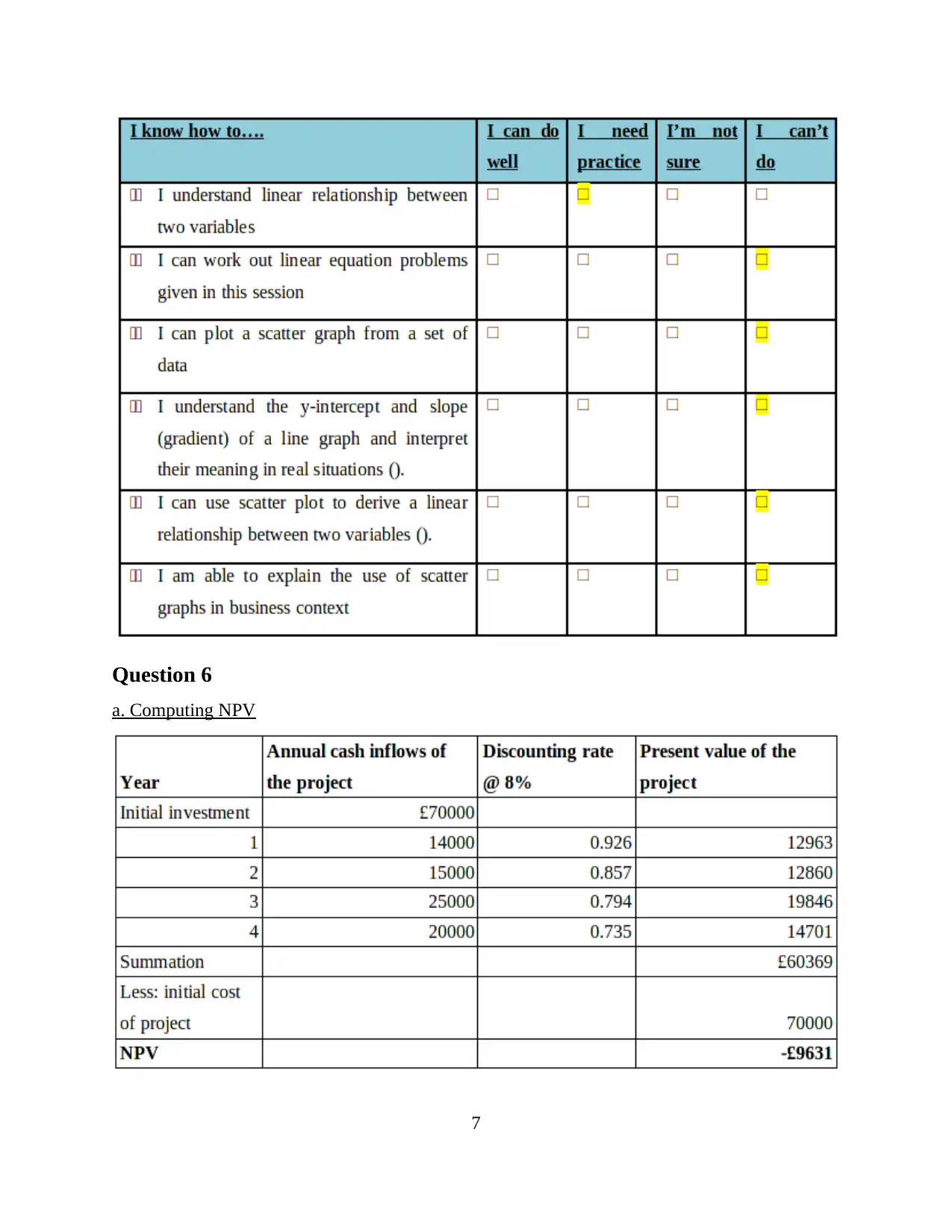
Question 6
a. Computing NPV
7
a. Computing NPV
7
Paraphrase This Document
Need a fresh take? Get an instant paraphrase of this document with our AI Paraphraser
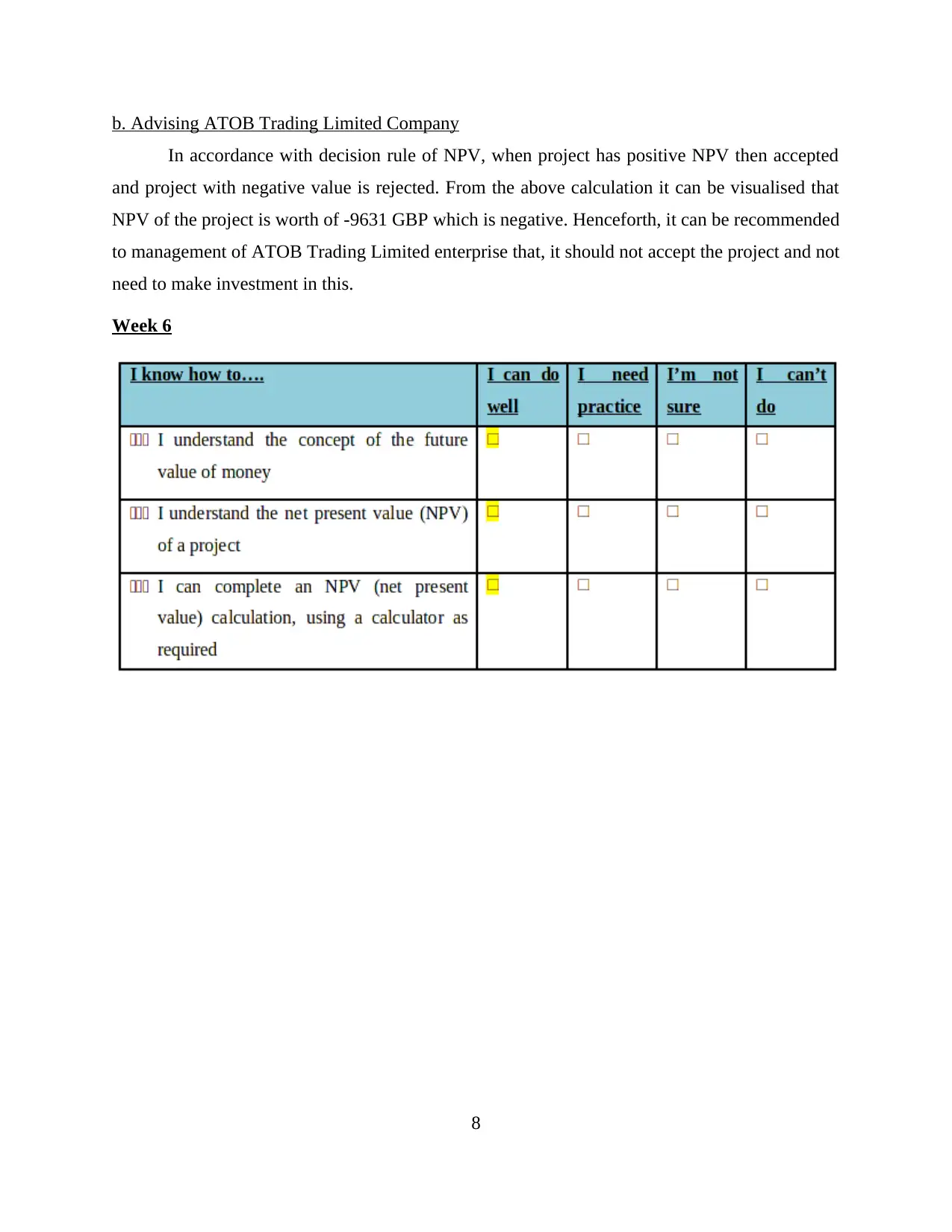
b. Advising ATOB Trading Limited Company
In accordance with decision rule of NPV, when project has positive NPV then accepted
and project with negative value is rejected. From the above calculation it can be visualised that
NPV of the project is worth of -9631 GBP which is negative. Henceforth, it can be recommended
to management of ATOB Trading Limited enterprise that, it should not accept the project and not
need to make investment in this.
Week 6
8
In accordance with decision rule of NPV, when project has positive NPV then accepted
and project with negative value is rejected. From the above calculation it can be visualised that
NPV of the project is worth of -9631 GBP which is negative. Henceforth, it can be recommended
to management of ATOB Trading Limited enterprise that, it should not accept the project and not
need to make investment in this.
Week 6
8
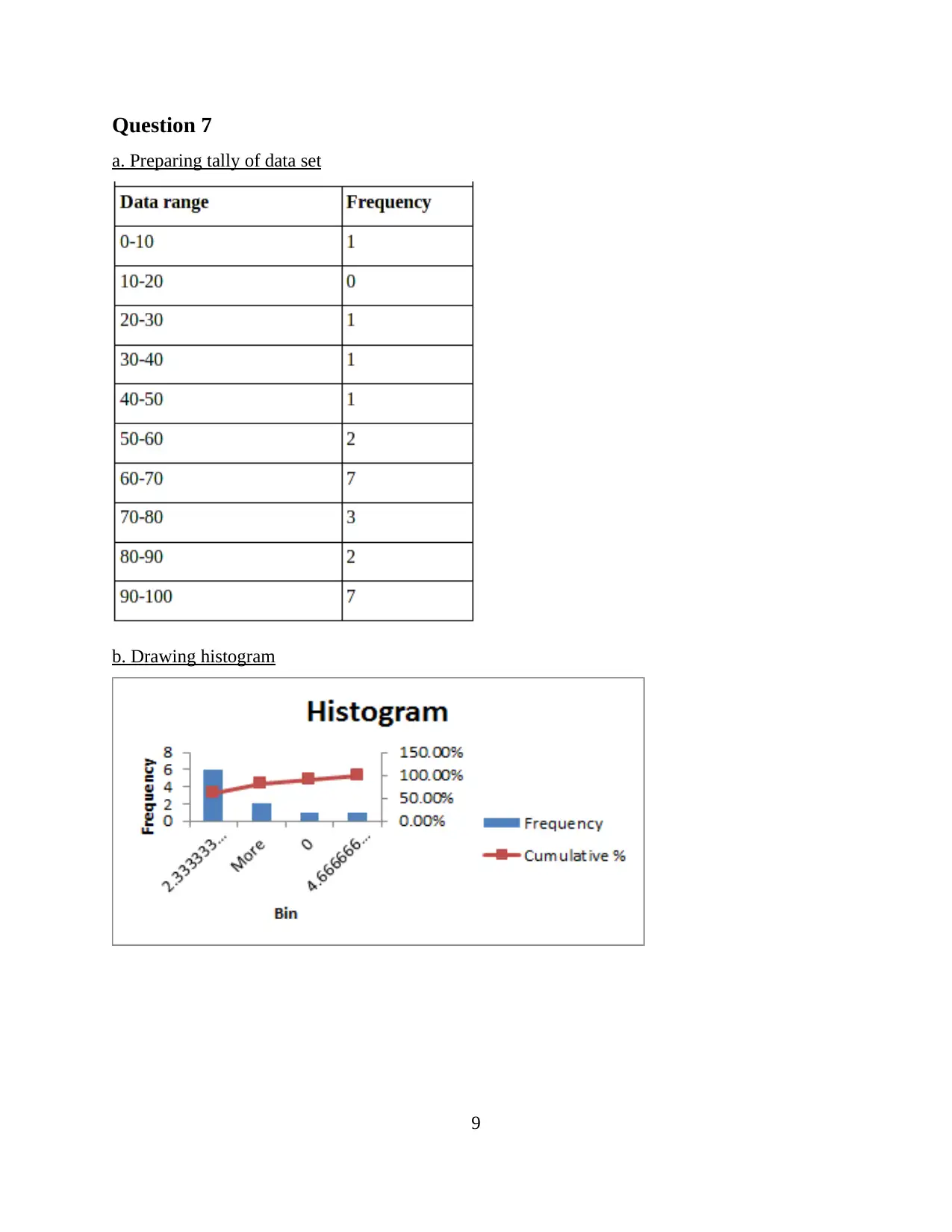
Question 7
a. Preparing tally of data set
b. Drawing histogram
9
a. Preparing tally of data set
b. Drawing histogram
9
⊘ This is a preview!⊘
Do you want full access?
Subscribe today to unlock all pages.

Trusted by 1+ million students worldwide
1 out of 17
Related Documents
Your All-in-One AI-Powered Toolkit for Academic Success.
+13062052269
info@desklib.com
Available 24*7 on WhatsApp / Email
![[object Object]](/_next/static/media/star-bottom.7253800d.svg)
Unlock your academic potential
Copyright © 2020–2025 A2Z Services. All Rights Reserved. Developed and managed by ZUCOL.


![Business Numeracy Portfolio Assignment - Weeks 1-8 - [University Name]](/_next/image/?url=https%3A%2F%2Fdesklib.com%2Fmedia%2Fimages%2Fol%2Fc8b0710628094746a512982ff40e7887.jpg&w=256&q=75)


